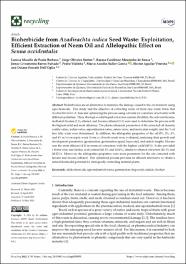Mostrar el registro sencillo del ítem
Bioherbicide from Azadirachta indica Seed Waste: Exploitation, Efficient Extraction of Neem Oil and Allelopathic Effect on Senna occidentalis
| dc.contributor.author | De Paulo Barbosa, Larissa Macelle | |
| dc.contributor.author | Oliveira Santos, Jorge | |
| dc.contributor.author | Mouzinho de Sousa, Rayssa Carolinne | |
| dc.contributor.author | Barros Furtado, Jomar Livramento | |
| dc.contributor.author | Vidinha, Pedro | |
| dc.contributor.author | Suller Garcia, Marco Aurelio | |
| dc.contributor.author | Aguilar Vitorino, Hector | |
| dc.contributor.author | Dall’Oglio, Daiane Fossatti | |
| dc.date.accessioned | 2023-10-17T16:34:38Z | |
| dc.date.available | 2023-10-17T16:34:38Z | |
| dc.date.issued | 2023-05-24 | |
| dc.identifier.uri | https://hdl.handle.net/20.500.13053/9559 | |
| dc.description.abstract | “Bioherbicides are an alternative to minimize the damage caused to the environment using agrochemicals. This study had the objective of extracting neem oil from ripe waste fruits that Azadirachta indica A. Juss and optimizing the process using solvents (or a mixture of solvents) with different polarities. Then, through a solid-liquid extraction system (Soxhlet), the solvents hexane, methanol/hexane (1:1), ethanol, and hexane/ethanol (1:1) were used to determine the process with the highest yield and most efficiency. The physicochemical parameters of the extracted oil (density, acidity value, iodine value, saponification value, esters value, and molecular weight) and the % of free fatty acids were determined. In addition, the allelopathic properties of the oil (0%, 2%, 3%, and 4% m/v) on septic weed Senna occidentalis seeds were evaluated, analyzing their growth and development parameters (germination, germination speed, hypocotyl, and radicle length). Hexane was the most efficient (4 h) in neem oil extraction, with the highest yield (43%). It also provided a better oleic and linoleic acid content (41.3% and 18.6%), similar to ethanol extraction (41.1% and 20.22%). Moreover, the allelopathic properties were more prominent for the oils extracted with hexane and hexane/ethanol. This optimized process provides an efficient alternative to obtain a natural herbicidal potential for strategically controlling harmful plants.“ | es_PE |
| dc.format | application/pdf | es_PE |
| dc.language.iso | spa | es_PE |
| dc.publisher | MDPI | es_PE |
| dc.rights | info:eu-repo/semantics/openAccess | es_PE |
| dc.rights.uri | https://creativecommons.org/licenses/by/4.0/ | es_PE |
| dc.subject | allelochemicals; agro-industrial-waste; germination; hypocotyl; radicle; Soxhlet | es_PE |
| dc.title | Bioherbicide from Azadirachta indica Seed Waste: Exploitation, Efficient Extraction of Neem Oil and Allelopathic Effect on Senna occidentalis | es_PE |
| dc.type | info:eu-repo/semantics/article | es_PE |
| dc.identifier.doi | https://doi.org/10.3390/recycling8030050 | |
| dc.type.version | info:eu-repo/semantics/publishedVersion | es_PE |
| dc.publisher.country | NLD | es_PE |
| dc.subject.ocde | 3.03.00 -- Ciencias de la salud | es_PE |
Ficheros en el ítem
Este ítem aparece en la(s) siguiente(s) colección(es)
-
SCOPUS [380]


